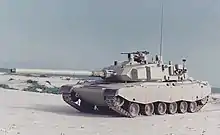EE-T1 Osório
The Engesa EE-T1 Osório was a Brazilian main battle tank prototype developed by Engesa. The tank was intended to be sold first to Arab and other Third World countries, jump-starting production — and enabling the Brazilian Army to later place its own orders without having to fund development costs. Development of the tank was initially privately funded by Engesa, but cashflow issues eventually led to the Brazilian government extending a loan to assist the program. Two prototypes of the tank were built, but the EE-T1 was never adopted for service.
| EE-T1 Osorio | |
|---|---|
 Engesa EE-T1 Osorio | |
| Type | Main battle tank |
| Place of origin | Brazil |
| Service history | |
| Used by | See Users |
| Production history | |
| Designer | Engesa |
| Designed | 1982–86 |
| Manufacturer | Engesa |
| Unit cost | $ 6,855,859.20 BRL, ($3,840,261.00 USD) |
| Produced | 1986 |
| No. built | 2 prototypes |
| Specifications | |
| Mass | 42.9 short tons (38.9 t; 38.3 long tons) |
| Length | 9.99 metres (32 ft 9 in) |
| Width | 3.26 metres (10 ft 8 in) |
| Height | 2.37 metres (7 ft 9 in) |
| Crew | 4 (commander, gunner, loader, driver) |
| Armor | composite, including aluminum/steel, carbon fibers, and ceramics. |
Main armament | 120 mm GIAT G1 smoothbore gun(P2), 105 mm L/52 L7 rifled gun(P1), |
Secondary armament | M2HB 12.7 mm machine gun x2 (coaxial and roof mounted) |
| Engine | 12-cylinder MWM TBD 234 Diesel engine 1,100 hp [1] |
| Power/weight | 26 hp/tonne |
| Suspension | hydropneumatic |
Operational range | 550 km (340 mi) [1] |
| Maximum speed | 70 km/h (43 mph) |
Development
The EE-T1 was envisioned by Engesa as a cost-effective tank made using domestically produced components. The tanks was intended for the foreign market - primarily third world countries - as opposed for use by the Brazilian Army.[2] Development started in 1982 and the first prototype was completed in 1985.[1] The initial development of the tank was expensive and caused a cashflow crisis at Engesa, prompting the Brazilian National Development Bank to extend a $65 million loan to finance the program in 1987.[3]
The tank was seen by some sources as an example of Brazil's modernizing defense industry, while others noted that the tank continued to use imported parts; according to an anonymous Engesa official cited in the Latin American Research Review, the EE-T1 would make heavier use of imported parts (including the tank's turret) when compared to the company's armored cars.[2] One source noted that the tank was reportedly comparable to American and European MBTs, but also expressed that some where skeptical of the EE-T1's commercial viability.[4] The production model of the EE-T1 was considered to be less expensive than other Western MBTs, with one source calculating it as costing $1.5-2 million per unit.[2] The tank was reportedly considered for adoption by Algeria, Iraq, Libya, and Saudi Arabia, but these potential deals never materialized.[1][2] The loss of the Saudi Arabian deal was particularly devastating and led to the EE-T1 remaining in the prototype stage. The program stalled by Engesa's bankruptcy filing in 1993 and was scrapped following the collapse of Brazilian armored vehicle industry in the late-1990s.[5]
Users
References
- Gelbart, Marsh (1996). Tanks main battle and light tanks. Brassey’s UK Ltd. pp. 13–14. ISBN 1-85753-168-X.
- Neto, Raul De Gouvea (1991). "How Brazil Competes in the Global Defense Industry". Latin American Research Review. 26 (3): 83–107. ISSN 0023-8791.
- Conca, Ken. "Technology, the Military, and Democracy in Brazil." Journal of Interamerican Studies and World Affairs 34, no. 1 (1992): 141-77. Accessed November 28, 2020. doi:10.2307/166152.
- Kapstein, Ethan B. "The Brazilian Defense Industry and the International System." Political Science Quarterly 105, no. 4 (1990): 579-96. Accessed November 28, 2020. doi:10.2307/2150936.
- Conca, Ken. "Between Global Markets and Domestic Politics: Brazil's Military-Industrial Collapse." Review of International Studies 24, no. 4 (1998): 499-513. Accessed November 28, 2020. http://www.jstor.org/stable/20097547.
External links
- Fprado.com
- Enemyforces.com
- Engesa EE-T1 Osório, the first brazilian MBT (in Portuguese with 'google translate' option)
- Military Today - Osório